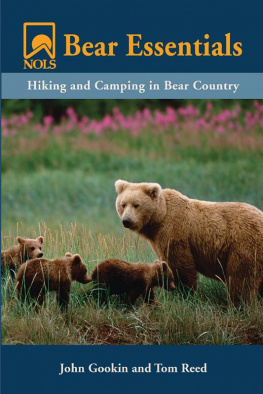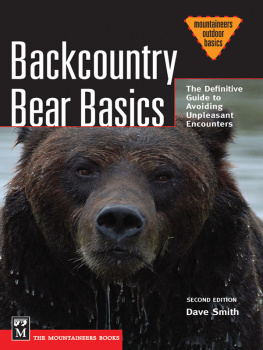
NOLS
Bear Essentials

Copyright 2009 National Outdoor Leadership School
Published by
STACKPOLE BOOKS
5067 Ritter Road
Mechanicsburg, PA 17055
www.stackpolebooks.com
All rights reserved, including the right to reproduce this book or portions thereof in any form or by any means, electronic or mechanical, including photocopying, recording, or by any information storage and retrieval system, without permission in writing from the publisher. All inquiries should be addressed to Stackpole Books, 5067 Ritter Road, Mechanicsburg, Pennsylvania 17055.
First edition
Cover design by Caroline Stover
Cover photograph courtesy of Thomas D. Mangelsen, www.mangelsen.com
Library of Congress Cataloging-in-Publication Data for the Print Edition
Reed, Tom, 1961
NOLS Bear Essentials : hiking and camping in bear country / John Gookin and Tom Reed. John Gookin and Tom Reed. 1st ed.
p. cm.
Includes index.
ISBN-13: 978-0-8117-3549-0 (alk. paper)
ISBN-10: 0-8117-3549-4 (alk. paper)
1. Black bearBehavior. 2. Grizzly bearBehavior. 3. CampingSafety measures. 4. HikingSafety measures. 5. Bear attacksNorth AmericaPrevention. 6. Outdoor recreationNorth AmericaSafety measures. I. Gookin, John. II. Title.
QL737.C27R44 2009
796.50289dc22
2008051645
eBook ISBN: 978-0-8117-4117-0

QED stands for Quality, Excellence and Design. The QED seal of approval shown here verifies that this eBook has passed a rigorous quality assurance process and will render well in most eBook reading platforms.
For more information please click here.
NOLS
Bear Essentials
Hiking and Camping
in Bear Country
John Gookin
and Tom Reed
STACKPOLE
BOOKS
THIS BOOK cannot and does not alert you to all the hazards of the mountains. It is a learning tool and should be read and studied as a supplemental source only. It is not a substitute for professional instruction, an experienced mentor, or, most importantly, the wilderness experience itself. If you decide to participate in the activities described in this book, the risk and responsibility for the outcome are solely yours. No one associated with the publication of this book, including NOLS, John Gookin, and Tom Reed, accepts responsibility for any injury or property damage that may result from participation in such activities.
Acknowledgments
Sincere thanks to our colleagues in the field of bear management for their help in reviewing the text of this book. Any errors in combining their various expert opinions are ours, not theirs.
Tom Smith, Brigham Young University, Bear Researcher
Brian Debolt, Wyoming Game & Fish, Bear Management Officer
Mark Bruscino, Wyoming Game & Fish, Bear Management Officer
Bill Stiver, Great Smoky Mountains National Park, Wildlife Biologist
Victoria Serer, Yosemite National Park, Bear Manager
Ben Tabor, New York Department of Environmental Conservation, Wildlife Technician
Introduction
Welcome to bear country! Bears are clever, powerful, and magnificent animals. Like people, each bear is unique, so the advice in this book is general in nature and cant prepare you for every behavior of every bear. Since 1965, NOLS has camped in bear country for over three million nights with only one injury directly caused by a bear, so the practices used by NOLS to camp and hike in bear country are based on significant experience. We also stay in touch with some of the worlds top bear scientists and have taken a leadership role in developing techniques that help us coexist with wild bears. But even with this cumulative expertise, we still consider ourselves to be constant students of bear behavior.
Our most important attitude is one best explained by the Koyukon people of Alaska. Anthropologist Richard Nelsons book Make Prayers to the Raven: A Koyukon View of the Northern Forest portrays the Koyukon people living harmoniously with bears for thousands of years. We are visiting bears in their home, and if we learn about bears and respect them in their natural habitat, our two species can coexist.
Your decision to camp in bear country comes with responsibilities to camp and hike in ways that respect the natural activities of bears. This isnt as complicated as it might seem. It takes a little knowledge about bears and a lot of self-discipline. Campers who respect the natural habits of bears can usually coexist with bears with few problems. Keep the following points in mind:
A fed bear is a dead bear. Bears that receive food from humans, intentionally or not, develop dangerous unnatural habits and are often destroyed. In some areas, wildlife managers try moving them away from human activity first, but a lot of these bears do eventually get euthanized. Many wildlife managers have given up on attempts to move problem animals, because in their areas it just postpones the inevitable once a bear has been conditioned by humans to seek us out for food.
A fed bear is a deadly bear. Wild bears have very few interactions with people. They usually avoid us like the plague. But once people start feeding bears, these bears become food-conditioned and habituated to people. Wild bears that become more comfortable around people are extremely dangerous. Studies have shown that many bear-caused human injuries are associated with habituated, food-conditioned bears (Herrero, 2002). The people who get hurt by these bears are often not the folks who give the bears the most food initially, but the future campers who are approached by these habituated bears.
Bears have an incredible sense of smell.
One summer a whale washed ashore from the Beaufort Sea and shortly thereafter satellite-tracked polar bears started swimming towards it from up to 120 km (75 miles) away. Sense of smell is much more significant for bears than for people. Once bears get a small food reward and associate that foods smell with the smell of humans, they easily detect your food (and you) from miles away. They also are curious about smells and might come exploring if they smell something new.
Problem bears arent born that way; they are trained by people. Campers who have sloppy camps or somehow give bears positive rewards for coming near humans cause most backcountry bear problems. A lack of negative consequences associated with coming near people leads to habituation. The bears learn to associate food with the smell of humans, and the rewards condition the bears to become more comfortable around people. This is elementary bear psychology.
Bears fear other bears. Bear ecologists say that when bears have nightmares they dont dream of humans, they dream of other bears. Thirteen to forty-four percent of young grizzly bears get killed by an adult bear, depending on the region (Schwartz, Miller & Haroldson, 2003, p. 590). Since bears usually have twins, many surviving bears have seen a brother or sister get killed by another bear. This has some important effects on bear behavior:
- sows are extremely protective of their cubs, and
- bears that are surprised by humans often react to defend themselves.
Next page










